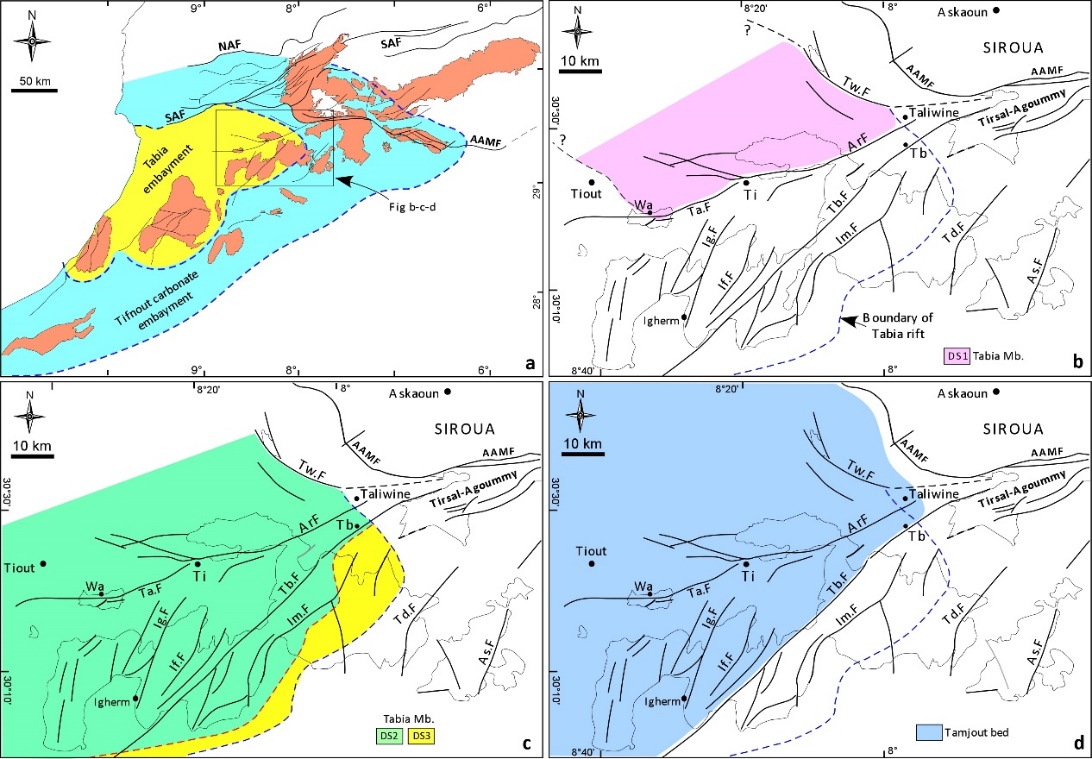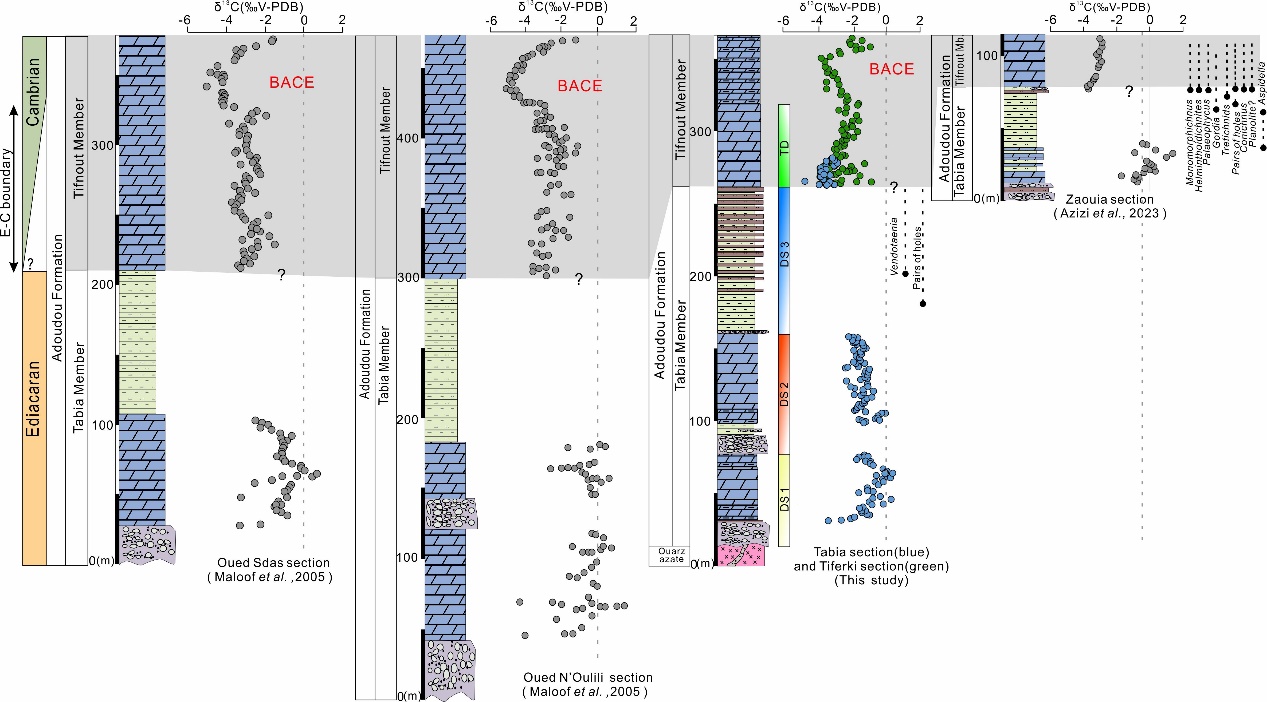The Ediacaran–Cambrian transition (ECT) marks one of the most pivotal intervals in evolutionary history, characterized by the emergence and rapid radiation of multicellular life. A robust global chronostratigraphic framework is crucial for elucidating the processes underlying this major biological innovation and its relationship to coeval paleoenvironmental changes. Morocco's Anti-Atlas region preserves one of the most complete late Ediacaran to early Cambrian carbonate successions globally (Figure 1), providing an exceptional natural laboratory for such investigations. Nevertheless, the absence of definitive biostratigraphic markers and incomplete understanding of basin tectonics have resulted in persistent uncertainties regarding both the precise placement of the Ediacaran–Cambrian boundary (the Cambrian Base) and its connection to the basin's tectonic-sedimentary evolution.
To address these questions, Dr. Yiwei Xiong from the Early Evolution of Earth-Life System team at the Nanjing Institute of Geology and Palaeontology, Chinese Academy of Sciences, under the guidance of Professors Bo Chen and Maoyan Zhu, collaborated with Professor El Hafid Bouougri (Cadi Ayyad University, Morocco) and colleagues. The team conducted a systematic, interdisciplinary study of the Tabia section in Morocco’s Anti-Atlas, their work yielded two key findings:
- First identification of four distinct tectono-sedimentary evolutionary phases in the Anti-Atlas Basin during the Ediacaran-Cambrian transition (Figure 2);
- A revised definition of the regional Ediacaran-Cambrian boundary.
These results underwent peer review and were published in Gondwana Research on June 6, 2025.
This study reveals that the Tabia Member experienced three distinct syn-rift tectono-sedimentary evolutionary stages, transitioning to a post-rift stage in the overlying Tifnout Formation (Figure 2). Systematic geochemical analyses support this interpretation. The syn-rift dolostones of the Tabia Formation display characteristically elevated ⁸⁷Sr/⁸⁶Sr ratios, positive Eu/Eu* anomalies, and significant enrichment in Mn, Pb, Fe, and Zn (Figure 3), indicating dolomitization influenced by mixed hydrothermal-seawater fluids (Figure 4). In contrast, the post-rift dolostones of the Tifnout Formation show substantially diminished hydrothermal signatures (Figure 3), consistent with seawater-dominated dolomitization (Figure 4). These contrasting geochemical patterns document the basin's tectonic transition from syn-rift to post-rift conditions.
Furthermore, the investigation revealed the presence of Vendotaenia macroalgae, a diagnostic late Ediacaran index fossil, within shale horizons of the Tabia member's third sedimentary sequence (DS3). Integrated with regional chemostratigraphic correlations, this study precisely constrained the base of Cambrian (the BACE - Basal Cambrian Carbon Isotope Excursion) to a position approximately 50 meters above the Tamjout Dolomite (Figure 5). This defined boundary exhibits remarkable concordance with the basin's major tectonic transition surface. The study demonstrates that the BACE negative carbon isotope excursion represents a globally synchronous chronostratigraphic marker, thereby establishing a robust standard for identifying the Ediacaran-Cambrian boundary not only in the Anti-Atlas but also in coeval sedimentary basins worldwide.
The research was supported by the National Key Research and Development Program of China and the National Natural Science Foundation of China.
Reference: Yiwei Xiong, Bo Chen*, Xiaojuan Sun, Kai Chen, Ibtissam Chraiki, Aihua Yang, Chunlin Hu, Zhixin Sun, Bing Pan, Chuan Yang, Tianchen He, Miao Lu, Tao Li, Fangchen Zhao, Maoyan Zhu, El Hafid Bouougri. 2025. Integrated analyses of the Ediacaran-Cambrian boundary sequence in northern Gondwana (Anti-Atlas platform, Morocco). Gondwana Research 145: 79–106. https://doi.org/10.1016/j.gr.2025.05.003.

Figure 1 Simplified map along the northern margin of West African Craton (WAC) showing the occurrence of the Late Ediacaran-Cambrian strata in the Anti-Atlas and composite δ13Ccarb profile of the Ediacaran-Lower Cambrian sequence in the Anti-Atlas

Figure 2 Paleogeography and tectono-sedimentary evolution across the Ediacaran-Cambrian transition Synrift stage 1 (DS1): The rift initiationSynrift stage 2, (DS 2): Faults reactivated and rift propagation, Synrift stage 3 (DS3): Continued basin growth, tectonic subsidence and marine transgression, Postrift stage: Stable carbonate platform and thermal subsidence

Figure 3 Boxplot for comparing all data-features of the Dolomite type 1 and Dolomite type 2.
Figure 4 Interpretative geological sectionshowing the conceptual model for the formation mechanism of the Dolomite type 1 (a) and Dolomite type 2 (b) (not to scale)

Figure 5 Carbon isotope chemostratigraphic and biostratigraphic correlation between the Tabia, Oued Sdass, Oued N’Oulili and Zaouia sections in Anti-Atlas platform
Download:
